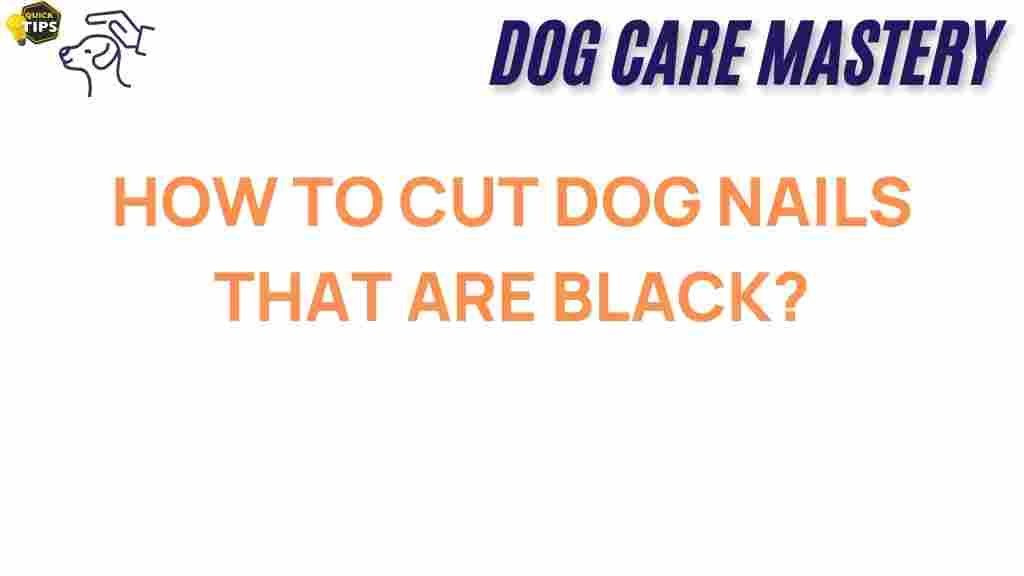Dog Nail Trimming: Mastering the Art of Trimming Black Dog Nails Safely
Trimming your dog’s nails is an essential part of pet care that often gets overlooked. For dog owners, especially those with black dogs, nail trimming can be a daunting task. The challenge lies in the difficulty of seeing the quick—the sensitive area that contains blood vessels and nerves. This article will guide you through the process of dog nail trimming, ensuring that you and your furry friend have a safe and stress-free experience.
Why Regular Dog Nail Trimming is Important
Regular nail trimming is crucial for your dog’s overall health and well-being. Here are some reasons why:
- Prevents Pain and Discomfort: Overgrown nails can lead to pain, discomfort, and even injury to your dog.
- Improves Mobility: Long nails can affect your dog’s gait and mobility, leading to joint pain over time.
- Protects Your Home: Trimming your dog’s nails prevents scratches on your floors and furniture.
- Promotes Better Hygiene: Regular nail trimming helps maintain your dog’s paw health and prevents infections.
Gathering Your Dog Nail Trimming Supplies
Before you begin, it’s essential to gather all the necessary supplies. Here’s what you will need:
- Dog nail clippers (scissor-type or guillotine-type)
- A nail file or grinder
- Styptic powder or cornstarch (for bleeding control)
- Treats for positive reinforcement
- A well-lit area
Step-by-Step Guide to Dog Nail Trimming
Now that you’re equipped with the right tools, follow these steps to trim your black dog’s nails safely:
Step 1: Get Your Dog Comfortable
Before you start the trimming process, it’s vital to make your dog feel comfortable. Consider the following:
- Choose a quiet space with minimal distractions.
- Use a non-slip surface, such as a mat or towel, to help your dog feel secure.
- Have someone help you hold your dog if they are anxious.
Step 2: Examine the Nails
For black dogs, it’s crucial to identify where the quick is. Unlike lighter-colored nails, the quick is harder to see in black nails. Follow these tips:
- Look for the natural curve of the nail; the quick is usually about 2-3 millimeters from the tip.
- Trim small amounts at a time to avoid cutting into the quick.
- Use a flashlight to help illuminate the nail if necessary.
Step 3: Begin Trimming
Now it’s time to start trimming:
- Hold the paw firmly but gently.
- Use your dog nail clippers to cut the tip of the nail at a slight angle.
- Trim only a small portion at a time, especially if you’re unsure where the quick is.
- If you see a dark spot in the center of the nail, stop cutting to avoid hitting the quick.
Step 4: Smooth the Edges
After trimming, use a nail file or grinder to smooth out any sharp edges. This step helps prevent your dog from scratching themselves or you.
Step 5: Reward Your Dog
Always reward your dog after the trimming session. This positive reinforcement encourages them to cooperate during future trims. Use treats, praise, or playtime as incentives.
Troubleshooting Common Issues
Even with careful preparation, you may encounter challenges while trimming your dog’s nails. Here are some common issues and how to address them:
Problem: Dog is Anxious or Fearful
If your dog is fearful of nail trimming, try these tips:
- Start by letting them sniff the clippers before attempting to trim.
- Practice handling their paws regularly to get them used to the process.
- Consider using a calming spray or pheromone diffuser before the session.
Problem: Accidental Quick Cutting
If you accidentally cut into the quick and your dog starts to bleed:
- Stay calm to avoid panicking your dog.
- Apply styptic powder or cornstarch directly to the bleeding nail.
- Hold pressure for a few minutes until the bleeding stops.
Problem: Refusal to Cooperate
If your dog won’t sit still during the process, consider these options:
- Take breaks to prevent overwhelming your dog.
- Try trimming just one or two nails at a time and gradually work up to all nails.
- Use treats to encourage them to stay calm and still.
When to Seek Professional Help
If you feel uncomfortable trimming your dog’s nails or if your dog has severe anxiety, it’s best to seek professional help. Groomers and veterinarians are trained to handle nail trimming safely and efficiently.
Conclusion
Mastering the art of dog nail trimming can significantly improve your black dog’s quality of life. With the right tools, techniques, and a little patience, you can make the process safe and stress-free. Remember to take it slow, reward your dog, and don’t hesitate to seek professional help if needed. For more information on pet care, check out this informative resource. Happy trimming!
If you have any questions about dog nail trimming or need further assistance, feel free to reach out or consult with your veterinarian for personalized advice.
This article is in the category Grooming and created by dogcaremastery Team
